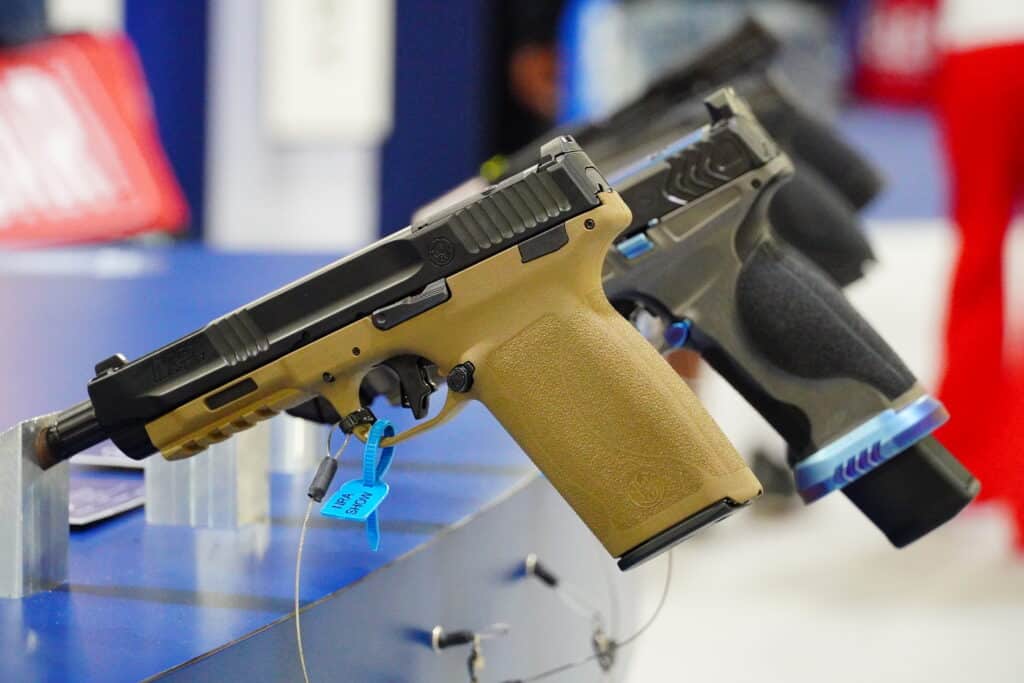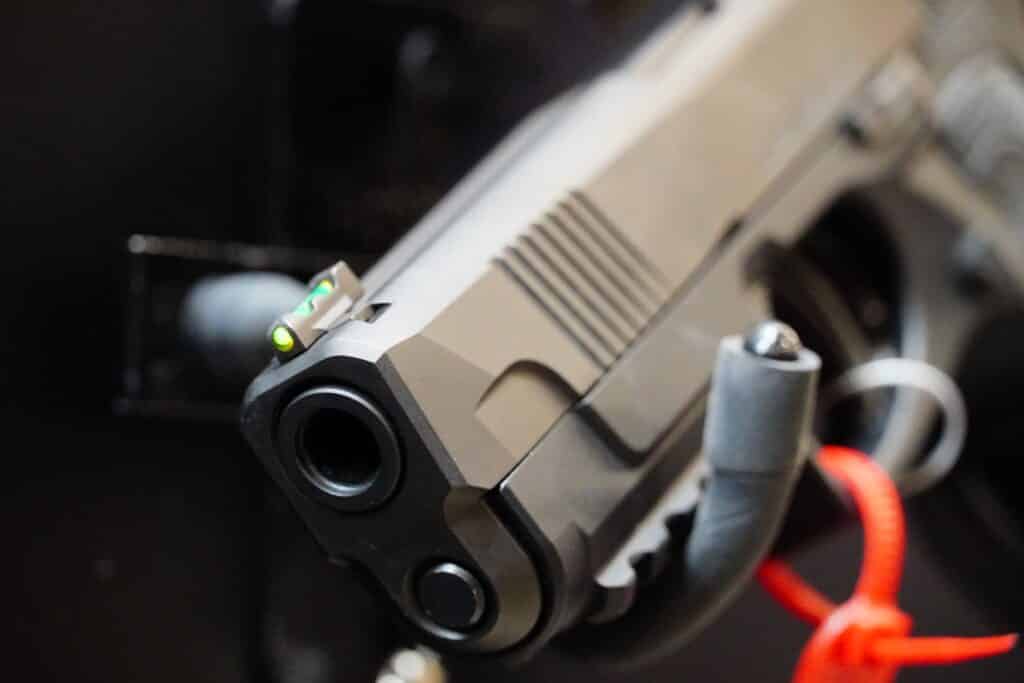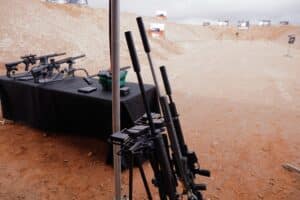This week saw a pair of legal battles over different groups of prohibited persons flesh out the contours of the Second Amendment.
The first fight is over non-violent felons. Two notable cases make it more likely the Supreme Court weighs in, even if the Department of Justice doesn’t want them to get involved.
The other fight deals with people convicted of domestic violence misdemeanors. The Fourth Circuit, perhaps unsurprisingly, thought that group is close enough to those subject to domestic violence restraining orders that they mostly just copied and pasted the reasoning from Rahimi. But they also addressed the biggest difference between the two.
Plus, crime data analyst Jeff Asher joins the podcast to discuss his prediction murder could hit a record low in 2025. And I do my best to explain why gun-rights groups are mad at the House GOP over reconciliation and the National Firearms Act on the news update podcast.

Analysis: The Coming DOJ-SCOTUS Showdown Over Felon Gun Rights [Member Exclusive]
By Jake Fogleman
Fights over non-violent felon gun rights—including those featuring highly sympathetic plaintiffs—continue to pile up at the Supreme Court’s doorstep. The Department of Justice (DOJ) has asked the Court not to weigh in, but hasn’t fleshed out its rights restoration process alternative.
Last week, the en banc Ninth Circuit Court of Appeals added another potential candidate to the coming deluge when it upheld Steven Duarte’s conviction for being a felon in possession of a firearm. Duarte, whose rap sheet includes multiple previous convictions for crimes ranging from vandalism and drug possession to evading police, argued that because his criminal history included only non-violent offenses, he should retain Second Amendment protections.
The Ninth Circuit disagreed.
“To support the application of § 922(g)(1) to Duarte, the Government proffers a variety of historical sources that evince two regulatory principles that: (1) legislatures may disarm those who have committed the most serious crimes; and (2) legislatures may categorically disarm those they deem dangerous, without an individualized determination of dangerousness,” Judge Kim McLane Wardlaw wrote for the majority. “We address each in turn, and agree that either supplies a basis for the categorical application of § 922(g)(1) to felons.”
As a result, the largest appellate court in the country now joins the Fourth, Eighth, Tenth, and Eleventh Circuits in refusing to distinguish between violent and non-violent criminals for the purposes of categorical, lifetime disarmament. Assuming Duarte appeals the decision, which seems likely, it could present a compelling opportunity for the High Court to address the now deepened circuit split with the Third, Fifth, and Sixth Circuits, which have all recognized an ability for individualized challenges to the federal ban by non-violent offenders.
But even before that can happen, an even more enticing option may have already entered the Court’s queue. Earlier this month, lawyers representing Melynda Vincent filed a petition for certiorari over the Tenth Circuit’s decision in her case not to accept as-applied challenges to the felon gun ban.
Like Duarte, Vincent is also a non-violent felon, but her story paints a far more sympathetic picture. Her sole disqualifying conviction came in 2008, when she was homeless and wrote a fraudulent $498 check at a grocery store. She was convicted of felony bank fraud, sentenced to probation without ever serving time in jail, and has not reoffended. She is now a mother and an employed social worker with multiple master’s degrees, but is nevertheless permanently prohibited from owning a gun to protect her family.
Given the optics of calling into question the most commonly enforced federal gun law, the justices may find it easier to do so by accepting a case like Vincent’s, where even most hardline gun-control advocates would have a difficult time arguing she is too dangerous for consideration.
Casting a shadow over these cases and more, however, is the DOJ and its current stance on non-violent felons. In recent weeks, the DOJ has tipped its hand over its preferred strategy in dealing with the question, and it involves keeping the issue off of the Supreme Court’s docket.
In the case of Bryan Range, a Pennsylvania man with a 30-year-old state misdemeanor conviction for understating his income on a food stamp application, the Third Circuit ruled the ban violated his Second Amendment rights. However, DOJ intentionally chose not to file an appeal with the justices.
“The Department of Justice has concluded that a petition for a writ of certiorari is not warranted in this case,” Solicitor General John Sauer wrote a letter sent to the Senate Judiciary Committee last month. “The Third Circuit’s decision is narrow, leaving Section 922(g)(1) untouched except in the most unusual applications.”
Sauer filed similar remarks responding to two pending petitions in felon-in-possession challenges at the Supreme Court last month, arguing that the issue “does not warrant this Court’s review.”
Around the same time, the Attorney General’s Office also revealed the first signs of life for its renewed rights restoration process. It published a notice granting relief to ten individuals, including actor and prominent Donald Trump supporter Mel Gibson.
Presumably, someone like Vincent would be an easy candidate for rights restoration under the new process. But of course, that would first require a functional process to actually be in place. The agency has not issued any guidelines on how future candidates beyond the initial ten might apply, nor has it responded to multiple requests for comment on the details. That, however, has not stopped the Department from citing this to-be-determined process as an additional reason for the Court not to grant any felon-in-possession cases.
“Although there is some disagreement among the courts of appeals regarding whether Section 922(g)(1) is susceptible to individualized as-applied challenges, that disagreement is shallow,” Sauer wrote in Hunt v. United States. “And any disagreement among the circuits may evaporate given the Department of Justice’s recent reestablishment of the administrative process under 18 U.S.C. 925(c) for granting relief from federal firearms disabilities.”
The DOJ has not yet had a chance to respond to Vincent’s petition, but it’s a safe bet to assume that those same arguments will reappear to rebut her request for Supreme Court relief. At which point, all eyes will be on the justices to see how they weigh the promise of an amorphous rights restoration program versus the ongoing controversy roiling the lower courts over a law that impacts thousands of individuals every year.
The Court has thus far shown a willingness to weigh in and establish that the government can disarm people found by courts to be dangerous. Time will soon tell if they are willing to do the same for people like Melynda Vincent, who have never been found to be dangerous but are nevertheless permanently deprived of Second Amendment rights. Perhaps after Vincent, they’ll look at Duarte’s less-clear-cut case as well.
Podcast: Will Murder Hit Record Lows in 2025? (Ft. Crime Analyst Jeff Asher) [Member Early Access]
By Stephen Gutowski
This week, we’re talking about some good news. Some very good news, actually.
The murder rate, which has been on the decline for a couple of years now, is on pace to hit a record low. That’s what the early data collected by Jeff Asher’s AH Datalytics indicates. Asher joins the show to break down the numbers he’s seeing so far.
He said the murder rate surged during the pandemic, but it has already fallen back to those levels and kept dropping further.
While the FBI’s murder data for 2025 won’t be out for nearly a year, Asher collects crime data from many of the same sources. He said his data shows a huge early decline in the murder rate that would equate to an all-time low if sustained. He cautioned that the decline is likely to slow as the year progresses, but it should still hit a record.
You can listen to the show on your favorite podcast episode or by clicking here. Video of the episode is available on our YouTube channel. An auto-generated transcript is here. Reload Members get access on Sunday, as always. Everyone else can listen on Monday.
Plus, Contributing Writer Jake Fogleman and I unpack the latest in the growing political fight between gun-rights groups and the House GOP over how much National Firearms Act reform can be included in the President’s “big beautiful bill” through budget reconciliation. We also cover recent rulings out of the federal courts, including an en banc Ninth Circuit decision upholding the government’s ability to permanently disarm all non-violent felons and a Fourth Circuit ruling the same for those with misdemeanor domestic violence convictions. Emily Stanley, aka Princess and the Pistol, also joins the show to discuss becoming a gun meme.

Analysis: The Fourth Circuit Cites Rahimi to Uphold Domestic Violence Misdemeanor Gun Ban [Member Exclusive]
By Stephen Gutowski
A new federal appeals court ruling relied heavily on the Supreme Court’s precedent in US v. Rahimi to uphold the domestic violence misdemeanor gun ban.
On Wednesday, a unanimous Fourth Circuit panel dismissed a facial challenge to the federal prohibition on gun possession by domestic abusers. It argued the case asked very similar questions to those addressed in Rahimi and, thus, the panel came to the same conclusion as the High Court. That makes it one of only a handful of federal appeals courts to broadly apply the Supreme Court’s most recent Second Amendment case, which has not left as much of an impact on lower courts as the Justices may have hoped.
“The historical regulatory tradition Rahimi relied on to uphold the constitutionality of § 922(g)(8) under Bruen’s framework is materially indistinguishable from how that same tradition would apply to § 922(g)(9),” Judge G. Steven Agee wrote for the court in US v. Nutter. “As was true of § 922(g)(8), when enacting § 922(g)(9), Congress was ‘restrict[ing] gun use to mitigate demonstrated threats of physical violence, just as surety and going armed laws do.’ And although none of the Founding Era limitations Rahimi relied on match § 922(g)(9) any more than they did § 922(g)(8), Rahimi made it clear that they need not do so to be ‘relevantly similar’ for purposes of Bruen. An ‘analogue’ suffices. Thus, as was true in Rahimi, § 922(g)(9) ‘s purpose and method—i.e., its ‘why’ and the ‘how’—fall within the Nation’s historical tradition.”
After a district court initially ruled the federal gun prohibition for domestic abusers “fits easily within” the history and tradition of disarming people deemed “a threat to the public safety,” as the High Court’s 2022 New York State Rifle and Pistol Association v. Bruen precedent requires, defendant David Nutter appealed. He argued that finding was wrong and there is no historical tradition of disarming abusers to be found in or around the Founding Era as Bruen demands. However, he didn’t find any more sympathetic ears on the three-judge appeals panel.
Judge Agee, a George W. Bush appointee, instead outlined the panel’s view of how to properly do the Breun test for domestic violence disarmament in light of Rahimi.
“At its core, Rahimi held that ‘our Nation’s tradition of firearm regulation distinguishes citizens who have been found to pose a credible threat to the physical safety of others from those who have not’ and ‘allows the Government to disarm individuals who present a credible threat to the physical safety of others.’” he wrote. “‘Section 922(g)(9), which categorically disarms individuals with valid, domestic-violence convictions, fits well within this historical tradition.’ As the definition of a ‘misdemeanor crime of domestic violence’ confirms, every individual that § 922(g)(9) would disarm has been convicted of an offense in which they had been adjudicated by a court of law to have used or attempted to use physical force or threatened the use of deadly force against their victim. § 921(a)(33)(A).”
Nutter argued the domestic violence misdemeanor gun ban was distinct from the one connected to the restraining order gun ban because it is permanent. He noted the temporary nature of Rahimi’s gun prohibition was a key factor in the Supreme Court’s decision to uphold that ban. But Judge Agee rejected that distinction as not meaningful because, he reasoned, at least some charges brought over illegal possession under the misdemeanor ban happen shortly after it is imposed.
“True, Rahimi noted the temporary nature of the restraining order at issue in § 922(g)(8) as part of its reasoning,” he wrote. “But that does not meaningfully distinguish § 922(g)(9), at least with regard to a facial challenge, because it still has a ‘plainly legitimate sweep.’ Put differently, § 922(g)(9) ‘s facial constitutionalitydoes not falter in light of this temporal argument because some § 922(g)(9) convictions arebrought within relatively close proximity to the predicate misdemeanor conviction andadditional fact-specific circumstances—such as the nature or number of the offenses—could otherwise support disarmament.”
While Nutter had made some attempt to argue the law was unconstitutional as applied to his decades-old convictions in addition to on its face, the court ruled he didn’t make that claim properly and only the facial challenge was valid. To that end, it also noted the prohibition wasn’t necessarily a lifetime gun ban because there are several avenues for defendants to have their convictions wiped out or rights restored.
“Among other things, it would not prohibit firearm possession by those whose convictions have been set aside, pardoned, or expunged, nor would it apply to those who have had their civil rights fully restored, unless the condition of any of those events expressly prohibited firearms-related conduct,” Judge Agee wrote. “Moreover, if the underlying conviction involved a misdemeanor crime of domestic violence ‘against an individual in a dating relationship,’ then the conviction would exclude the defendant from § 922(g)(9) ‘s scope ‘if 5 years have elapsed from the later of the judgment of conviction or the completion of the person’s custodial or supervisory sentence, if any, and the person has not subsequently been convicted of another such offense.’”
Judge Agee further argued the Supreme Court only noted the temporary nature of the restraining order ban as part of the discussion surrounding how it is applied, and the Court might view the misdemeanor ban differently.
“Nutter’s temporal argument also discounts that, at least in part, the SupremeCourt’s concern with the temporal limits of § 922(g)(8) related to the correspondinglylower standards that apply to obtain a restraining order, while § 922(g)(9) ‘s longerprohibition flows from a correspondingly higher standard to obtaining a conviction,” he wrote.
The panel concluded domestic violence convictions are equally as justifiable a reason on their face to disarm somebody under the Second Amendment as domestic violence restraining orders. Although, it did leave room open for a potential as-applied challenge for somebody, potentially even Nutter himself, who has been subject to the prohibition for an extended period of time.
“Arguments that a prior conviction should not permanently ban an individual from possessing firearms based on the amount of time that has lapsed since a conviction or a defendant’s purported rehabilitation are better suited to as-applied challenges or as policy arguments to Congress to advocate amending the statutory language,” Judge Agee wrote. “They are not concerns that would render § 922(g)(9) unconstitutional on its face.”
That’s it for now.
I’ll talk to you all again soon.
Thank you,
Stephen Gutowski
Founder
The Reload







